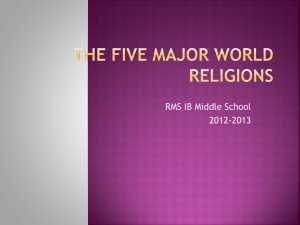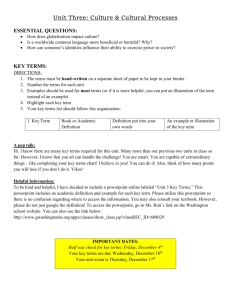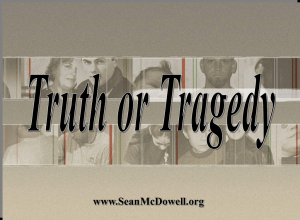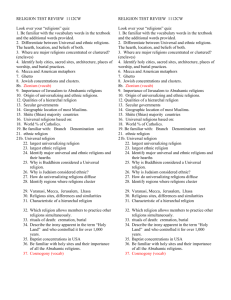AP Human Geography, Chapter 6.3 and 6.4 Notes 6.3 Why Do
advertisement
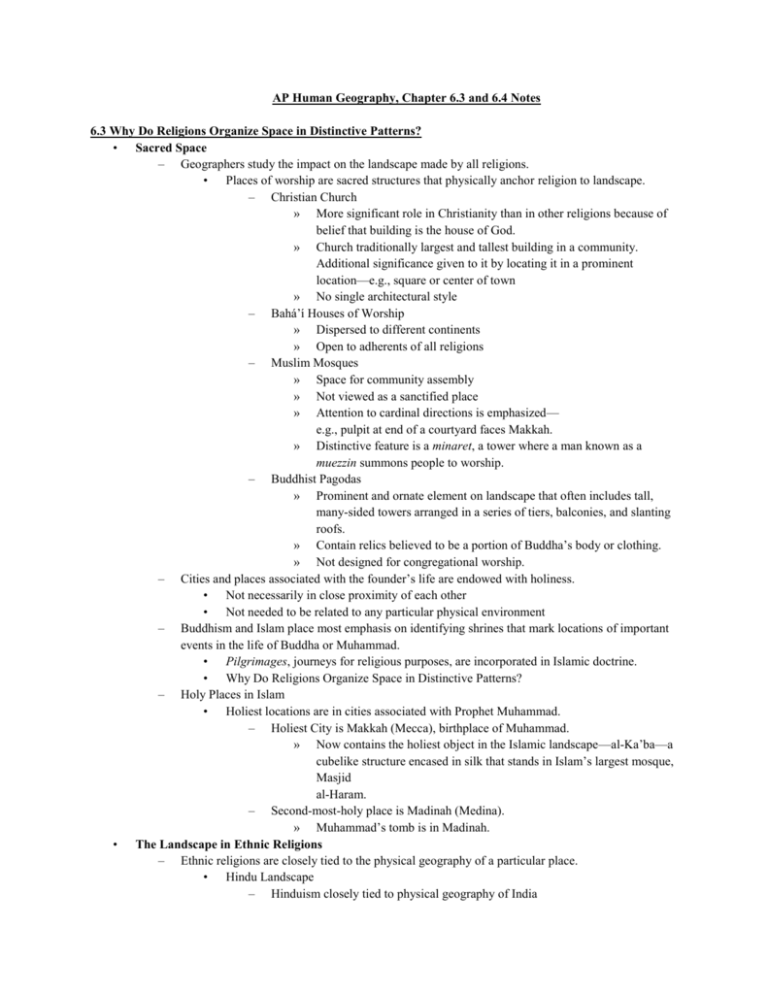
AP Human Geography, Chapter 6.3 and 6.4 Notes 6.3 Why Do Religions Organize Space in Distinctive Patterns? • Sacred Space – Geographers study the impact on the landscape made by all religions. • Places of worship are sacred structures that physically anchor religion to landscape. – Christian Church » More significant role in Christianity than in other religions because of belief that building is the house of God. » Church traditionally largest and tallest building in a community. Additional significance given to it by locating it in a prominent location—e.g., square or center of town » No single architectural style – Bahá’í Houses of Worship » Dispersed to different continents » Open to adherents of all religions – Muslim Mosques » Space for community assembly » Not viewed as a sanctified place » Attention to cardinal directions is emphasized— e.g., pulpit at end of a courtyard faces Makkah. » Distinctive feature is a minaret, a tower where a man known as a muezzin summons people to worship. – Buddhist Pagodas » Prominent and ornate element on landscape that often includes tall, many-sided towers arranged in a series of tiers, balconies, and slanting roofs. » Contain relics believed to be a portion of Buddha’s body or clothing. » Not designed for congregational worship. – Cities and places associated with the founder’s life are endowed with holiness. • Not necessarily in close proximity of each other • Not needed to be related to any particular physical environment – Buddhism and Islam place most emphasis on identifying shrines that mark locations of important events in the life of Buddha or Muhammad. • Pilgrimages, journeys for religious purposes, are incorporated in Islamic doctrine. • Why Do Religions Organize Space in Distinctive Patterns? – Holy Places in Islam • Holiest locations are in cities associated with Prophet Muhammad. – Holiest City is Makkah (Mecca), birthplace of Muhammad. » Now contains the holiest object in the Islamic landscape—al-Ka’ba—a cubelike structure encased in silk that stands in Islam’s largest mosque, Masjid al-Haram. – Second-most-holy place is Madinah (Medina). » Muhammad’s tomb is in Madinah. • The Landscape in Ethnic Religions – Ethnic religions are closely tied to the physical geography of a particular place. • Hindu Landscape – Hinduism closely tied to physical geography of India » » » • • • • • Mt. Kailas is holy because it is home to Siva. Holiest places are riverbanks and coastlines. Hindus believe that they achieve purification by bathing in holy rivers—e.g., Ganges River Solstice – Special significance in some ethnic religions » Stonehenge is a prominent remnant of a pagan structure aligned so that sun rises between two stones on solstices. Disposing of the Dead – Climate, topography, and religious doctrine combine to create differences in practices to shelter the dead. • Burial – Christians, Muslims, and Jews typically bury the deceased in designated areas called cemeteries. » Cemeteries were typically only public open space in congested urban places prior to the nineteenth century. • Cremation – Hindus wash the bodies of the deceased with water from the Ganges River first, then burn them with a slow fire on a funeral pyre. Religious Settlements and Place Names – Most human settlements serve an economic purpose, but some are established primarily for religious reasons. • Utopian settlement is an ideal community built around a religious way of life. – Salt Lake City culminated the utopian movement in the United States when it was built by the Mormons. – Roman Catholic immigrants have frequently given religious place names, or toponyms, to settlements primarily in the U.S. Southwest and Quebec. The Calendar – Universalizing and ethnic religions approach the calendar differently. • Ethnic Religion – Holidays are closely aligned with natural events associated with the physical geography of the homeland. – Prominent feature is celebration of the seasons. » Closely tied to local agriculture • Universalizing Religion – Major holidays relate to events in the life of the founder rather than the seasons of one particular place. » Ramadan (Islam): part of five pillars of faith » Easter (Christian): resurrection of Jesus Administration of Space – Universalizing religions must be connected to ensure consistency of doctrine. • Hierarchical Religions – Exemplifies a well-defined geographic structure and organizes territory into local administrative units. » Roman Catholic Church created administrative units on much of Earth’s inhabited land with each being headed by a leader who is accountable to the next higher-ordered leader. • Locally Autonomous Religions – Islam » No religious hierarchy » No formal territorial organization 6.4 Why Do Territorial Conflicts Arise among Religious Groups? • Religion versus Government Policies – Religious groups may oppose policies seen as contradicting their religious values. • Religion is element of cultural diversity that has led to most conflict in places. – Religious fundamentalism, a literal interpretation and strict adherence to basic principles of a religion, has spurred more intense conflict recently. • Taliban versus Western Values – Taliban’s control of Afghanistan’s government in the 1990s led to strict laws opposing Western values. » “Western, non-Islamic” leisure activities banned » Ex: Soccer stadiums converted to settings for executions and floggings. • Religion versus Religion – Conflicts most likely to occur at a boundary between two religious groups. • Religious Wars in Ireland – A small faction chose to join the United Kingdom when Ireland became independent in 1937. » 46 percent protestant and 40 percent Roman Catholic (2001) – Roman Catholics have been victimized by discriminatory practices, such as exclusion form higher-paying jobs and better schools. – Belfast, the capital city, is highly segregated. – Protests by Roman Catholics began in 1968 with bloodshed of both Protestants and Roman Catholics. • Religious Wars in the Middle East – Conflict in the Middle East is among the world’s longest standing. • Jews, Christians, and Muslims have fought nearly 2,000 years to control the same small strip of Land in the Eastern Mediterranean. – Judaism: special claim to the territory it calls the Promised Land where major events in the development in the religion occurred. – Islam: Muslim army conquered this land in seventh century A.D. Jerusalem is the third holiest city to Muslims, because it is believed to be where Muhammad ascended into heaven. – Christianity: considers it the Holy Land and Jerusalem the Holy City, because the major events in Jesus’s life, death, and resurrection occurred there. • Conflicting Perspectives of the Holy Land – After the 1973 war, the Palestinians emerged as Israel’s principal opponent. – Palestinians viewed themselves as the legitimate rulers of Israel. • Biggest obstacle to peace in the Middle East is the status of Jerusalem. – Peace will likely not be possible, if one religion has political control over Jerusalem.

